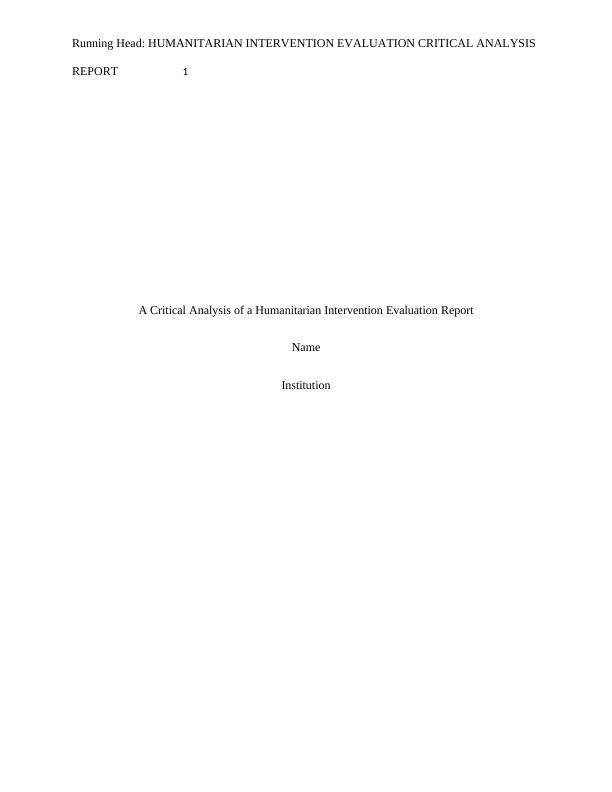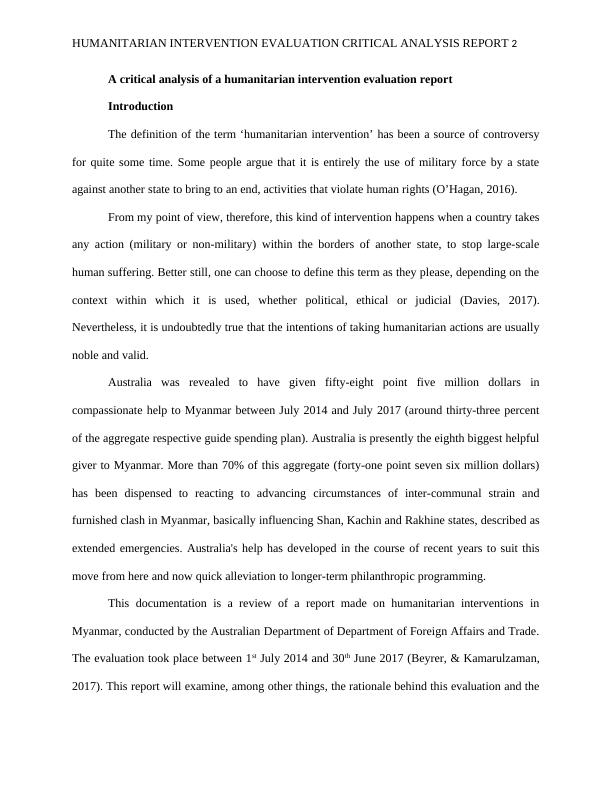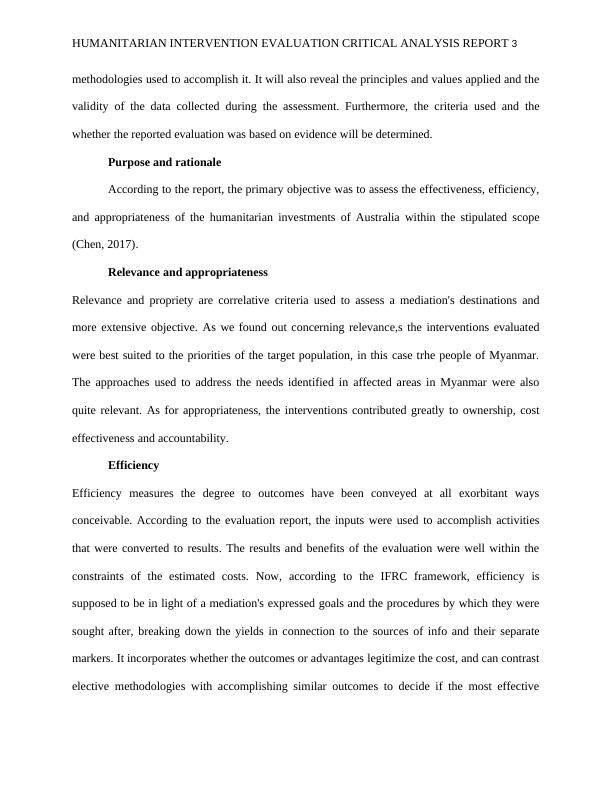A Critical Analysis of a Humanitarian Intervention
Added on 2021-06-15
16 Pages4256 Words77 Views
Running Head: HUMANITARIAN INTERVENTION EVALUATION CRITICAL ANALYSIS REPORT1A Critical Analysis of a Humanitarian Intervention Evaluation ReportNameInstitution

HUMANITARIAN INTERVENTION EVALUATION CRITICAL ANALYSIS REPORT2A critical analysis of a humanitarian intervention evaluation reportIntroductionThe definition of the term ‘humanitarian intervention’ has been a source of controversyfor quite some time. Some people argue that it is entirely the use of military force by a stateagainst another state to bring to an end, activities that violate human rights (O’Hagan, 2016). From my point of view, therefore, this kind of intervention happens when a country takesany action (military or non-military) within the borders of another state, to stop large-scalehuman suffering. Better still, one can choose to define this term as they please, depending on thecontext within which it is used, whether political, ethical or judicial (Davies, 2017).Nevertheless, it is undoubtedly true that the intentions of taking humanitarian actions are usuallynoble and valid.Australia was revealed to have given fifty-eight point five million dollars incompassionate help to Myanmar between July 2014 and July 2017 (around thirty-three percentof the aggregate respective guide spending plan). Australia is presently the eighth biggest helpfulgiver to Myanmar. More than 70% of this aggregate (forty-one point seven six million dollars)has been dispensed to reacting to advancing circumstances of inter-communal strain andfurnished clash in Myanmar, basically influencing Shan, Kachin and Rakhine states, described asextended emergencies. Australia's help has developed in the course of recent years to suit thismove from here and now quick alleviation to longer-term philanthropic programming.This documentation is a review of a report made on humanitarian interventions inMyanmar, conducted by the Australian Department of Department of Foreign Affairs and Trade.The evaluation took place between 1st July 2014 and 30th June 2017 (Beyrer, & Kamarulzaman,2017). This report will examine, among other things, the rationale behind this evaluation and the

HUMANITARIAN INTERVENTION EVALUATION CRITICAL ANALYSIS REPORT3methodologies used to accomplish it. It will also reveal the principles and values applied and thevalidity of the data collected during the assessment. Furthermore, the criteria used and thewhether the reported evaluation was based on evidence will be determined.Purpose and rationaleAccording to the report, the primary objective was to assess the effectiveness, efficiency,and appropriateness of the humanitarian investments of Australia within the stipulated scope(Chen, 2017). Relevance and appropriatenessRelevance and propriety are correlative criteria used to assess a mediation's destinations andmore extensive objective. As we found out concerning relevance,s the interventions evaluatedwere best suited to the priorities of the target population, in this case trhe people of Myanmar.The approaches used to address the needs identified in affected areas in Myanmar were alsoquite relevant. As for appropriateness, the interventions contributed greatly to ownership, costeffectiveness and accountability.EfficiencyEfficiency measures the degree to outcomes have been conveyed at all exorbitant waysconceivable. According to the evaluation report, the inputs were used to accomplish activitiesthat were converted to results. The results and benefits of the evaluation were well within theconstraints of the estimated costs. Now, according to the IFRC framework, efficiency issupposed to be in light of a mediation's expressed goals and the procedures by which they weresought after, breaking down the yields in connection to the sources of info and their separatemarkers. It incorporates whether the outcomes or advantages legitimize the cost, and can contrastelective methodologies with accomplishing similar outcomes to decide if the most effective

HUMANITARIAN INTERVENTION EVALUATION CRITICAL ANALYSIS REPORT4procedures have been received. It is firmly identified with viability and the estimation ofexecution.EffectivenessEffectiveness measures the degree to which an intercession has or is probably going toaccomplish its expected, prompt outcomes.the evaluation is said to have been timely andcoordinated. It took care of all the trade offs and ensured that perspectives of the stakeholderswere taken into account.CoverageCoverage alludes to the degree by which populace bunches are incorporated into or prohibitedfrom a mediation, and the differential effect on these gatherings. This evaluation is reported tohave been very inclusive and extensive. Evaluaton was done at different locations and withdifferent people of many divergent characteristics.The evaluation sought to know the levels of accuracy and relevance of Australia’shumanitarian assistance with regards to protracted crises in Myanmar, and other places ingeneral. Finally, the evaluation was conducted with the intention of finding out if the local ornational leadership, or both, were affected by Australia’s humanitarian activities; was theleadership in either case reinforced or undermined (Capie, 2015)? The evaluators derive theirevaluation questions from the chief strategy and policy document of Australia as well as frominternational models and frameworks.MethodologyThe main approach used for this process was qualitative. Stakeholders were interviewed,desk reviews conducted and discussions held in focus groups (Blake et al., 2017). Theresearchers also made short field trips to the affected areas to experience firsthand what the

End of preview
Want to access all the pages? Upload your documents or become a member.
Related Documents
Report on the IFRC Framework 5 International Federation of Red Cross and Red Crescent Societieslg...
|11
|3669
|93
Evaluation of a new evidence-based approach to informative researchlg...
|12
|4064
|364
Critical Analysis of an Evaluation Essaylg...
|14
|4015
|273
Evaluation of Humanitarian Response in Myanmarlg...
|18
|4476
|76
Critical Analysis of a Humanitarian Intervention Evaluation Reportlg...
|19
|4235
|378
Systematic Study Review.lg...
|12
|3031
|144
